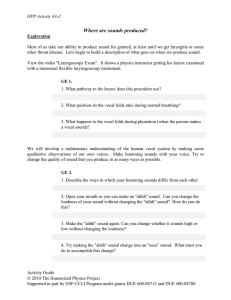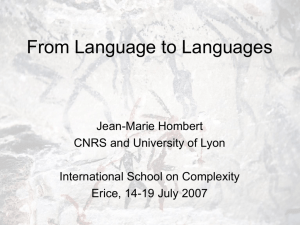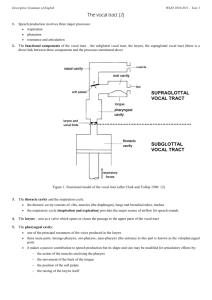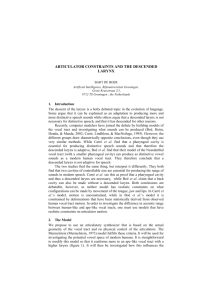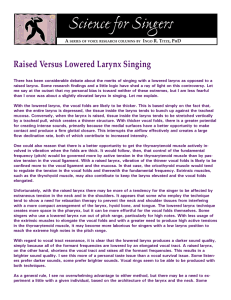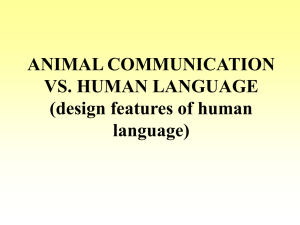Animal Communication and Language Evolution
advertisement
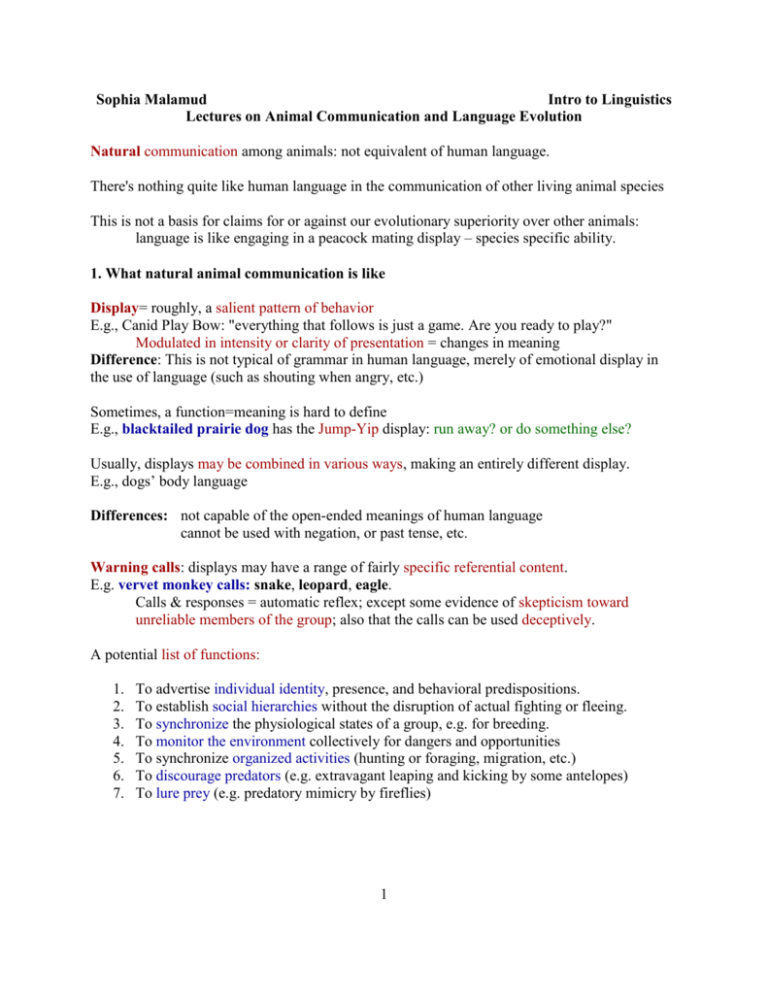
Sophia Malamud Intro to Linguistics Lectures on Animal Communication and Language Evolution Natural communication among animals: not equivalent of human language. There's nothing quite like human language in the communication of other living animal species This is not a basis for claims for or against our evolutionary superiority over other animals: language is like engaging in a peacock mating display – species specific ability. 1. What natural animal communication is like Display= roughly, a salient pattern of behavior E.g., Canid Play Bow: "everything that follows is just a game. Are you ready to play?" Modulated in intensity or clarity of presentation = changes in meaning Difference: This is not typical of grammar in human language, merely of emotional display in the use of language (such as shouting when angry, etc.) Sometimes, a function=meaning is hard to define E.g., blacktailed prairie dog has the Jump-Yip display: run away? or do something else? Usually, displays may be combined in various ways, making an entirely different display. E.g., dogs’ body language Differences: not capable of the open-ended meanings of human language cannot be used with negation, or past tense, etc. Warning calls: displays may have a range of fairly specific referential content. E.g. vervet monkey calls: snake, leopard, eagle. Calls & responses = automatic reflex; except some evidence of skepticism toward unreliable members of the group; also that the calls can be used deceptively. A potential list of functions: 1. 2. 3. 4. 5. 6. 7. To advertise individual identity, presence, and behavioral predispositions. To establish social hierarchies without the disruption of actual fighting or fleeing. To synchronize the physiological states of a group, e.g. for breeding. To monitor the environment collectively for dangers and opportunities To synchronize organized activities (hunting or foraging, migration, etc.) To discourage predators (e.g. extravagant leaping and kicking by some antelopes) To lure prey (e.g. predatory mimicry by fireflies) 1 3. Evolution of animal communication Most animal displays are thought of as ritualization of previously existing behavior, e.g. marking territory with urine ritualization of intention movements (incomplete acts), e.g.turning away, starting to fly Also: frowning from protective eyebrow-lowering part of preparations for attack/defense. Movements may be redirected or displaced from their normal context, repeated unnecessarily, etc. as part of ritualization. Instinctive vs. learned patterns Patterns of animal communication: mostly, but not entirely genetically determined. vervet monkeys all have the same cries=innate; baby vervets initially overextend = learning animals respond correctly to warning cries of other species: not innate to particular species some species have "dialects": some properties learned, during a critical period early in life Elaborate social evolution in the songs of humpback whales: arena behaviour for courtship Grammar -- without communication complex, quasi-grammatical structure, no communication: e.g., mouse grooming. Grammar ≠ actual language: language uses grammar to link form and meaning. 4. Size of the repertoire For most relatively social adult fishes, birds and mammals - from 15 to 35 displays: Cuttlefish = Chimps – no “great chain of being”! Human language: not just the logical endpoint of some obvious evolutionary scale. It’s a specific, enormously hypertrophied development of structures with rather different original functions (like peacock’s tail or elephant’s trunk) Pressures to prevent the accumulation of displays: they may become ecologically irrelevant; be too much investment required in the brain circuitry involved; be confusing if too many "lexical items", lessening the effectiveness of each. 5. Primate language instruction Apes do not have the right vocal tract configuration for speech: sign language or visual symbols. Apes can associate meanings with symbols. Can they combine the items in new ways? This is a hallmark of human language. 2 The evidence for novel combinations is weak: e.g., “apple which is orange-color” - in a sequence of fixed expressions; trainer introduced the color! Primate signing – NOT sign language, not real signs! 6. How human language seems to be different You should be able to fill this section in for yourself, based on the content of this course. The phonological principle,_______________________________________________________ Large lexicon__________________________________________________________________ Open lexicon__________________________________________________________________ Syntactic principles _____________________________________________________________ Hierarchical compositional semantics _______________________________________________ Variation in space and time_______________________________________________________ All of these seem to be missing from natural communication among non-human animals. Instead, animal communication has these characteristics Small vocabulary: usually about 10 distinct items Closed vocabulary: new "names" or similar items are not added System is fixed across space and time: widely separated populations use the same signals Messages are usually single items, perhaps with repetition Common points: Vocalizations communicate individual identity Vocalizations communicate attitude and emotional state Another difference: theory of mind, involving complex & abstract models of others' knowledge, beliefs, intentions and goals H.P. Grice (1913-1988): –"to communicate" & "to mean" can only be understood in terms of multiple layers of intentions and beliefs on the part of conversational participants; assumptions about norms of cooperative behavior (pragmatics) Gricean issues in discussions of animal communication: higher-order intensionality 3 Some potential advantages of the human innovations: Easy naming of new people, groups, places, things, etc. Ways of referring to past, present, and future Signs for an arbitrarily large inventory of abstract concepts Language learning is a large investment in social identity Puzzle: if communication systems are SO useful why other animals have put so little emphasis on elaborating them beyond this size of a few tens of hard-wired elements? 7. The evolution of human language Earlier ideas (19th century): Bow-Wow, Pooh-Pooh, Ding-Dong, Yo-Heave-Ho theories… 1876 Linguistic Society of Paris bans language evolution from its meetings and publications. Background scientific understanding was developing: general hominid paleontology the functioning of the larynx (paleo-)neurology ethology and the role of vocal displays: bird song, whale song studies of primate behavior, social organization, vocal signaling evolutionary theory 8. Is language in our genes? What aspects of the human genome make spoken language possible? What selective pressures on our ancestors led these characteristics to develop? Genetic basis for language: does it make sense? E.g. wearing basebal caps backwards is cultural, not genetic although it’s peculiar to humans. Genetics/physical evolution alone cannot tell the whole story. But, it is clear that the human species has in fact adapted genetically to facilitate the use of spoken language. Human ancestry Evolution during the roughly five million years since we separated from the ancestors of today's great apes (chimpanzee, gorilla, etc.). The language-related changes: the mouth and throat (i.e. the vocal tract), and the brain. Vocal tract changes in hominid evolution Adapting vocal tracts for speaking: shortened muzzle and the oral cavity it contains, and stretched out pharynx (throat) by lowering the larynx. Homo erectus (between about 1.8 million and 100,000 years ago): intermediate link 4 Side-effect: choking hazard; worse for men than for women: as secondary sexual characteristic of male humans, the larynx increases in size & moves even lower in the throat at puberty. Apes don’t have laryngeal sexual dimorphism, despite greater dimorphism in overall size The dimorphism in larynx size and position means, vocalization important to humans in ways that it is not to gorillas and chimps. Why? Voice pitch correlates with larynx size which correlates with body size. Larger larynx = lower voice generally signals a larger size. Adult male larynx: about 50% larger than that of the adult female, while other linear dimensions differ only by 8-9% on average: early language related to sexual competition. Brain changes: Brain got bigger Brain got reorganized: (1) reduced primary visual striate cortex, increased posterior parietal cortex (Wernicke’s) (2) reorganized frontal lobe: third inferior frontal convolution (Broca’s area) (3) strong cerebral asymmetries (right-handedness; language localisation in left hemisphere) Side-effects: 1. brain is ten times more expensive than other tissue: 2% of our body weight, consumes about 20% of our energy. 2. increased gestation period (ought to be born at 17, not 9 months), “premature” newborns- so long period of care for infants The whys: Terrence Deacon: what aspect of human social organization and adaptation wouldn’t benefit from the evolution of language? Derek Bickerton: language helps us to think better. Rational thought largely are inner speech. Crucial selective advantages of language were social: larger or more complex social groups. Deacon: Early hominids developed symbolic communication as a way to establish social contracts permitting stable family and group structures (allowing better hunting & scavenging). Grooming, Gossip, and the Evolution of Language, Robin Dunbar: language gossip – a more efficient substitute for grooming that primates use to establish and maintain social relationships. The Symbolic Species, Terrence Deacon: hominid brains & human language have co-evolved over the past two million years, driven by "a reproductive problem that only symbols could solve: the imperative of representing a social contract". Result: evolutionary adaption for improved symbolic communication, probably due to sexual selection (crudely, females preferred males who could make more convincing promises). Dunbar and Deacon might both be right “Spandrel” theories: Language is an accidental side-effect of larger brains 5

